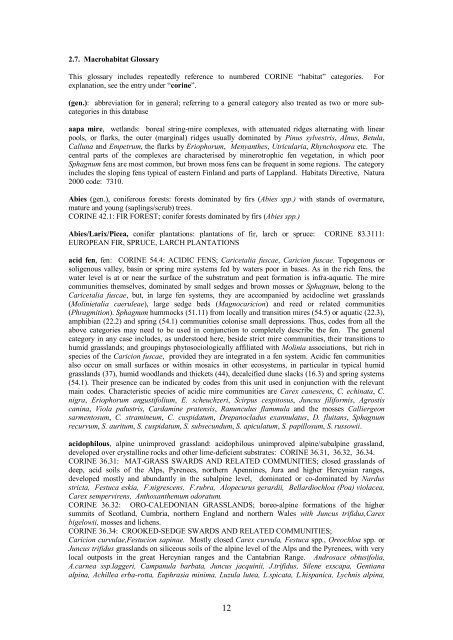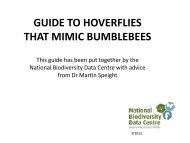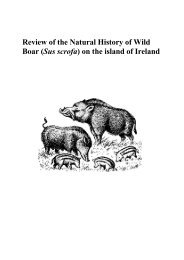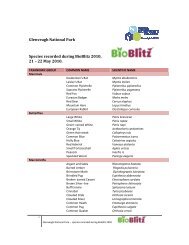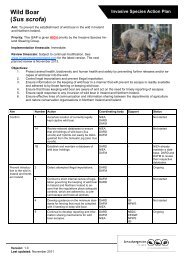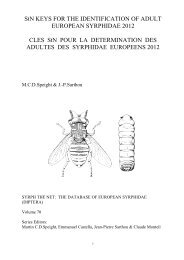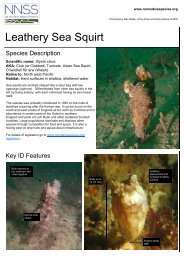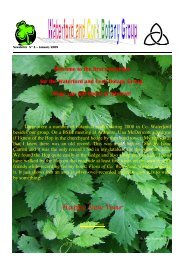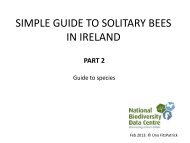StN DATABASE: CONTENT AND GLOSSARY OF ... - Pollinators
StN DATABASE: CONTENT AND GLOSSARY OF ... - Pollinators
StN DATABASE: CONTENT AND GLOSSARY OF ... - Pollinators
Create successful ePaper yourself
Turn your PDF publications into a flip-book with our unique Google optimized e-Paper software.
2.7. Macrohabitat Glossary<br />
This glossary includes repeatedly reference to numbered CORINE “habitat” categories. For<br />
explanation, see the entry under “corine”.<br />
(gen.): abbreviation for in general; referring to a general category also treated as two or more subcategories<br />
in this database<br />
aapa mire, wetlands: boreal string-mire complexes, with attenuated ridges alternating with linear<br />
pools, or flarks, the outer (marginal) ridges usually dominated by Pinus sylvestris, Alnus, Betula,<br />
Calluna and Empetrum, the flarks by Eriophorum, Menyanthes, Utricularia, Rhynchospora etc. The<br />
central parts of the complexes are characterised by minerotrophic fen vegetation, in which poor<br />
Sphagnum fens are most common, but brown moss fens can be frequent in some regions. The category<br />
includes the sloping fens typical of eastern Finland and parts of Lappland. Habitats Directive, Natura<br />
2000 code: 7310.<br />
Abies (gen.), coniferous forests: forests dominated by firs (Abies spp.) with stands of overmature,<br />
mature and young (saplings/scrub) trees.<br />
CORINE 42.1: FIR FOREST; conifer forests dominated by firs (Abies spp.)<br />
Abies/Larix/Picea, conifer plantations: plantations of fir, larch or spruce: CORINE 83.3111:<br />
EUROPEAN FIR, SPRUCE, LARCH PLANTATIONS<br />
acid fen, fen: CORINE 54.4: ACIDIC FENS; Caricetalia fuscae, Caricion fuscae. Topogenous or<br />
soligenous valley, basin or spring mire systems fed by waters poor in bases. As in the rich fens, the<br />
water level is at or near the surface of the substratum and peat formation is infra-aquatic. The mire<br />
communities themselves, dominated by small sedges and brown mosses or Sphagnum, belong to the<br />
Caricetalia fuscae, but, in large fen systems, they are accompanied by acidocline wet grasslands<br />
(Molinietalia caeruleae), large sedge beds (Magnocaricion) and reed or related communities<br />
(Phragmition). Sphagnum hummocks (51.11) from locally and transition mires (54.5) or aquatic (22.3),<br />
amphibian (22.2) and spring (54.1) communities colonise small depressions. Thus, codes from all the<br />
above categories may need to be used in conjunction to completely describe the fen. The general<br />
category in any case includes, as understood here, beside strict mire communities, their transitions to<br />
humid grasslands; and groupings phytosociologically affiliated with Molinia associations, but rich in<br />
species of the Caricion fuscae, provided they are integrated in a fen system. Acidic fen communities<br />
also occur on small surfaces or within mosaics in other ecosystems, in particular in typical humid<br />
grasslands (37), humid woodlands and thickets (44), decalcified dune slacks (16.3) and spring systems<br />
(54.1). Their presence can be indicated by codes from this unit used in conjunction with the relevant<br />
main codes. Characteristic species of acidic mire communities are Carex canescens, C. echinata, C.<br />
nigra, Eriophorum angustifolium, E. scheuchzeri, Scirpus cespitosus, Juncus filiformis, Agrostis<br />
canina, Viola palustris, Cardamine pratensis, Ranunculus flammula and the mosses Calliergeon<br />
sarmentosum, C. stramineum, C. cuspidatum, Drepanocladus exannulatus, D. fluitans, Sphagnum<br />
recurvum, S. auritum, S. cuspidatum, S. subsecundum, S. apiculatum, S. papillosum, S. russowii.<br />
acidophilous, alpine unimproved grassland: acidophilous unimproved alpine/subalpine grassland,<br />
developed over crystalline rocks and other lime-deficient substrates: CORINE 36.31, 36.32, 36.34.<br />
CORINE 36.31: MAT-GRASS SWARDS <strong>AND</strong> RELATED COMMUNITIES; closed grasslands of<br />
deep, acid soils of the Alps, Pyrenees, northern Apennines, Jura and higher Hercynian ranges,<br />
developed mostly and abundantly in the subalpine level, dominated or co-dominated by Nardus<br />
stricta, Festuca eskia, F.nigrescens, F.rubra, Alopecurus gerardii, Bellardiochloa (Poa) violacea,<br />
Carex sempervirens, Anthoxanthemum odoratum.<br />
CORINE 36.32: ORO-CALEDONIAN GRASSL<strong>AND</strong>S; boreo-alpine formations of the higher<br />
summits of Scotland, Cumbria, northern England and northern Wales with Juncus trifidus,Carex<br />
bigelowii, mosses and lichens.<br />
CORINE 36.34: CROOKED-SEDGE SWARDS <strong>AND</strong> RELATED COMMUNITIES;<br />
Caricion curvulae,Festucion sapinae. Mostly closed Carex curvula, Festuca spp., Oreochloa spp. or<br />
Juncus trifidus grasslands on siliceous soils of the alpine level of the Alps and the Pyrenees, with very<br />
local outposts in the great Hercynian ranges and the Cantabrian Range. Androsace obtusifolia,<br />
A.carnea ssp.laggeri, Campanula barbata, Juncus jacquinii, J.trifidus, Silene exscapa, Gentiana<br />
alpina, Achillea erba-rotta, Euphrasia minima, Luzula lutea, L.spicata, L.hispanica, Lychnis alpina,<br />
12


